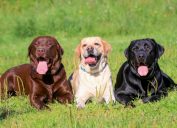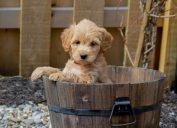5 Dog Breeds First-Time Pet Owners Should Never Get, Veterinarian Warns
They'll challenge you every chance they get.

Adding a dog to your family will bring loads of joy and companionship—and can even inspire you to exercise and interact with your neighbors on walks and visits to the dog run. However, dog ownership is not all sunshine and roses. It also requires training and discipline, and some dog breeds need more of those two things than others—meaning they aren't a good fit for first-time pet parents. In a recent video on TikTok, veterinarian Amir Anwary (@amirthevet) shared the dog breeds he says novices should avoid for various reasons, from their temperament to their trainability. Read on to learn which dogs made the list.
RELATED: 14 Hardest Dog Breeds to Own, Doggy Daycare Worker Says.
1
Belgian Malinois

The first breed Anwary mentions is the Belgian Malinois, a working dog historically owned by Belgian sheepherders and cattlemen, according to the American Kennel Club (AKC). It's that drive to work that makes these pups tough for novice owners.
"If you have ever seen a Mal perform an obedience routine, you know firsthand what a smart and eager breed this is," the AKC explains. "Problems set in, though, when this people-oriented dog is underemployed and neglected."
They need lots of exercise and mental stimulation to stay happy. If they don't get it, they could go after other animals and people due to their high prey drive—and at two feet tall with a muscular build, that could lead to disaster.
2
Chow Chow

With their curved ears and fluffy faces, these dogs look more like teddy bears than pups. But don't let their adorable exterior fool you: Chow Chows will challenge newbies.
According to the AKC, a well-socialized Chow Chow is "refined and dignified" with strangers, if a little aloof, and "eternally loyal" to their loved ones. However, if your Chow Chow isn't well-socialized, which can happen easily with an inexperienced owner, they can become aggressively territorial.
When it comes to trainability, these dogs are often called the cats of the canine world—which, based on the number of trained cats we've seen, means they'll probably give you a run for your money.
RELATED: The 10 Most Unique Dog Breeds, According to Pet Experts.
3
Dalmatian

Although these dogs are beloved by firefighters everywhere, Anwary says they aren't ideal for new owners. The spotted pups were historically used as coach dogs, accompanying the horse-drawn carriages of nobles and keeping watch over the other animals and their humans.
Because of that unique history, modern-day Dalmatians require tons of exercise and have a protective instinct, which can sometimes turn aggressive if a dog isn't socialized properly, according to the AKC.
4
Siberian Husky

The Siberian Husky is another breed that was developed to go the distance; they were originally kept as endurance sled dogs by the semi-nomadic Chukchi people in northeastern Asia. So, if you own one of these dogs, you better be ready to keep up—and, according to Anwary, many newbies aren't.
"These are energetic dogs who can't resist chasing small animals, so secure running room is a must," writes the AKC. They need lots of walks and runs and an owner who's willing to keep a watchful eye on them and provide them with strict training.
RELATED: The 10 Best Dogs for Beginners, Vets Say.
5
Australian Cattle Dog

This herding dog is related to Australia's wild dingos. And if that fact alone doesn't convince you that first-time owners probably shouldn't adopt them, then take Anwary's word for it.
"These resilient herders are intelligent enough to routinely outsmart their owners," writes the AKC. "If an ACD isn't challenged, it easily becomes bored and may get into mischief."
You'll need to engage them in working activities or agility training and keep them enormously active. If you're not sure you can provide those things—or aren't sure how—then this isn't the breed for you.
For more pet advice delivered straight to your inbox, sign up for our daily newsletter.





















